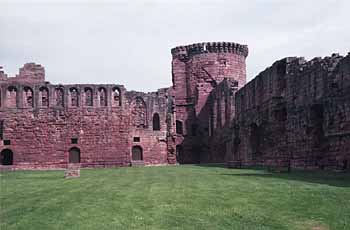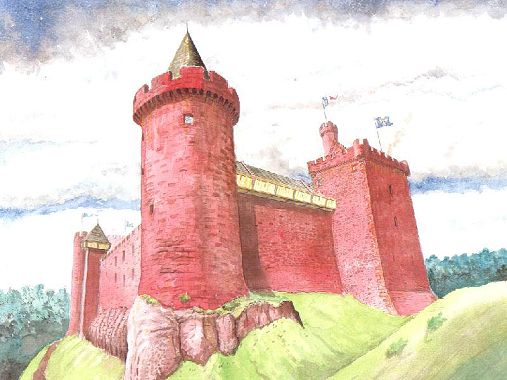 |
 |
 |
 |
|
CLAN HISTORY
I have found this information in many different places, mainly the internet. To go directly to the sources of this information
click on the link below
CLICK HERE
If you have any information on the family history or would like to ask a question or contact me for any
reason, please feel more than welcome to e-mail me on murraysonline@hotmail.com I check the e-mail every day and will always do my best to answer any questions or requests or help in any way
possible. thanks.
|
 |
|
|

This is a very important site for the Oliphant Clan for two reasons; firstly it is where Sir William Olifard, defender
of Stirling Castle is burried. Secondly it is where the mausoleum of the Chiefly Line (the Lords Oliphant and their
antecedants) is located. The site of the church has been moved from its original location, at the furthest extremity
of the churchyard (as the churchyard is today.) However, this area is slowly falling away into a revine. This
is where the mausoleum of the Chiefs is, and within a few years it too will have fallen into the ravine. It requires
urgent work in order to save this very important part of our Clans heritage. Who is responsible for maintaining it?
Can it be saved? The civic authority are responsible but are probably unaware of the critical problem. Yes it
can be saved but it is unlikely that the local authority (civic council) would be prepared to spend the funds required.
There was
also a marble effigy of Sir William, commander of Stirling, covering the entrance to the mausoleum but once the old church
had gone the effigy became extremely badly weathered. It has been moved to a recess inside the new church (which is
approximately 300 years old.) The church is kept locked but the keys are kept by the minister who lives in the Manse
at the top of the church drive.
Believed to have been begun by the Oliphants in the 1240's, Bothwell Castle is one of
Scotlands greatest and most impressive castles. Its famous circular 'Donjon' tower was built in the 13th Century and
is reguarded as the finest surviving castle for Scotland in that area. It is built of the local red sandstone and stands
high over the river Clyde which flows past its base.

|
| A view of Bothwell Castle from the inner bailey |
Sir Walter
Olifard, its founder, was Justicary of the Lothians. Because of his power and position, he needed a fortalise of comparable
importance. It seems that not long before a similar castle had been built in France called Coucy. That Bothwell
is so similar is no coincidence, King Alexander III of Scotlands mother, Marie de Coucy was sister to Engherrand de Coucy
who built the great castle of Coucy in France. The Oliphant estates in the South passed
through marriage to the Murray's (Walter de Moravia, from whom all titled members of the Murray Clan are descended.)

|
| An artistic reconstruction of Bothwell Castle by Andrew Spratt |
|
   |
 |
|
|
 |
   |
 |
|
|
 |
|
|
|
|
 |
 |
 |
 |
 |
ROSSIE HOUSE
|
This house has also changed name over the years. Once called Culteuchar by a branch of the Oliphant family who
started the original section of the building. Their heraldic date stones (two in all) still adorn the house to this
day. It was sold to the Oliphants of Rossie, who lived at Rossie Ochill. The Rossie Oliphants proceded to enlarge
the structure into a substantial house, not dissimilar to Gask in size.
ROSSIE OCHILL
This is the original home of the Oliphants of Rossie. As the
name suggests, like the Condies original home, in the Ochill Hills. When resold in 1988, it was described by the selling
agent as -
"A Truly Delightful Residential Sporting and
Agricultural Estate... A lovely 17th Century Country House with 3 Reception Rooms and 7 Bedrooms..."
Kinneddar is on the outskirts of Saline in Fife. Again built by the Oliphants,
and like so many others has date stones and intials of the Oliphants who owned it and built it. Although the house is
intact, the park has been completely turned into a housing estates, with the best part of 100 houses surrounding it.
Oliphants were living there until the end of the 19th Century, exactly when they ceased there and where their memerobilia
went is unknown to us.
Special note of Arniston must be made because of
it's contents. It has always been a Dundas house, but the estate was bought for the son of a second marriage of the
Chief of the Dundases. This marriage was to the ex-wife of Sir Alexander Oliphant of Kellie, Katherine Oliphant, sister
of the 4th Lord Oliphant. Arniston house has her portrait (circa 1670- the earliest Oliphant portrait currenly known,)
a tapestry made with what is believed to be the Kellie arms on it and also a very fine Venetian glass belonging her (nearly
430 years old!) This house is open to the public.
HOPETON HOUSE
|
This house also contains important Oliphant memerobilia.
A member of the Rossie Oliphants, Jane, married John Hope 2nd Earl of Hopeton (they were promoted still to be Marquess of
Linlithgow.) As a result her portrait was paHopeton. This house is well worth a visit, and is considered one of
the most magnificent palaces in Scotland.inted by Gainsborough and hangs in the dining room of
Please feel free to e-mail me on murraysonline@hotmail.com
|
 |
|




